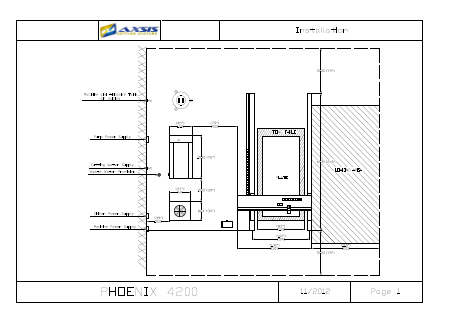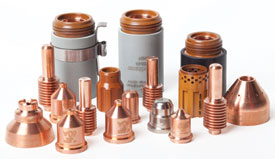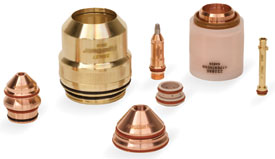FAQs
Plasma
1. What is a CNC cutting machine?
CNC stands for Computed Numerical Control; a CNC Machine is a machine that is controlled by a computer through a numerical program, this program is often in a format called G-code. At Axsis Technologies we use standard G-code, this is also used on a wide variety of CNC machines such as Lathes and Mills. 2D profiling CNC machines can use Plasma, Waterjets, or Routers to sever, route, or cut material into almost any 2D shape. CNC machines in industry have done this type of 2D profiling for over 25 years.
2. What can I use a plasma cutting system for?
Plasma cutting is ideal for cutting steel, and non-ferrous material less than 1 inch thick. Oxyfuel cutting requires that the operator carefully control the cutting speed so as to maintain the oxidizing process. Plasma is more forgiving in this regard. Plasma cutting really shines in some niche applications, such as cutting expanded metal, something that is nearly impossible with oxyfuel. And, compared to mechanical mean of cutting, plasma cutting is typically much faster, with Axsis Technologies, this is automatically controlled in the CNC controller.
3. What is Axsis Technologies HF (high- frequency) plasma
High Frequency Plasma is the same process as plasma cutting but the plasma beam is delivered through a much smaller nozzle orifice at higher velocity and results in more accurate profile cutting. A shield gas is also used to swirl around the plasma beam to constrict the beam and keep the cutting beam straight resulting in a square edge on the cut parts and better cut surface quality.
4. What is a "Virtually Dross free finish"?
A virtually dross free finish means that the cut edge finish is almost totally free from any molten remains of material still stuck to the underside of the part. A virtually dross-free finished edge will be able to be handled without any other de-burring process being necessary.
5. Which Power source (plasma) is right for me?
There are a number of factors to consider when purchasing a plasma cutting tool. They include cut capacity, cut quality, reliability, duty cycle, ease of use and operating cost. The first step is to figure out what type of plasma cutting you plan to do. Are you planning to cut by hand or on a table? Some plasma cutting tools are capable of doing both, going from handheld to mechanized cutting and back again. A few systems include a CNC interface and internal voltage divider, providing more options for mechanized applications.
Please call us or email us to discuss the suitable option for your application!
6. What are the Pros and Cons of a water table and down draft table?
This is a more difficult question.
- Pros:
- Downdraft:
- Applicable for a variety of metals
- Downdraft collects particles and fumes transferring them through a filter system to clean the air
- Easier to clean
- More versatile, if you desire expanding your production by extending the table, it is easier to do so with a downdraft
- Watertable:
- Best applicable for cutting mild steel
- Particles or fumes are pushed into the water so none remain in atmosphere
- Less expensive to install and operate because there's no need for a filter or a fume collector
- Downdraft:
- CONS:
- Downdraft:
- Filter must be changed regularly
- Occasionally different filters for different applications.
- More time consuming when removing or adjusting certain parts on the table, having to wait for them to be cool enough to handle with gloves or tongs
- Watertables:
- Water must be added on a regular basis along with chemicals to prevent algae growth
- Must also be drained periodically and legally disposed of
- When cutting aluminum, hydrogen bubbles can build up under the aluminum plate from the molten aluminum dropping into the water, creating the possibility of an explosion
- Downdraft:
7. How thick can I cut with Axsis's plasma?
Generally Plasma is used to cut mild steel between .1" (3mm) and upto 2" - 50mm thick, some plasma machines can even cut upto 3" (75mm) on and edge start.
8. Are plasma machines expensive to operate?
Plasma cutting machines are a very affordable way to 2D profile steel parts and good quality plasma machines require little maintenance. Most of the cost incurred while cutting comes from consumables such as Gas, Electrodes and Nozzles which are relatively cheap in comparison to the amount of cutting they can produce. Axsis Technologies use the best technology available to maximize consumable life and therefore minimizes the cost of cutting for the end user. When purchasing a machine make sure that the manufacturer can provide you with a good and timely supply of well-priced consumables.
9. How important is it to use original consumables and parts?
As a rule, third party or commercial consumables are cheaper than the original, but are their prices cost-effective? The answer is no! Axsis Technologies always recommends original consumables for your machine. Cheaper consumables will not last as long nor will they provide the same high-quality results. Even if these parts cost one fifth of the price, they will also last for one fifth to one tenth of the cutting time, resulting in being more expensive in the long run, not to mention the inferior quality of the finished product.
10. Where can I get my consumables and spare parts from for my equipment?
Axsis Technologies keeps a full stock of all the spare parts and consumable items required for your cutting system. We use all Genuine parts and consumables to ensure your optimum performance and cutting reliability of your equipment every time.
Please feel free to contact us for any questions on our parts.
Waterjet
1. What is a CNC cutting machine?
CNC stands for Computed Numerical Control; a CNC Machine is a machine that is controlled by a computer through a numerical program, this program is often in a format called G-code. At Axsis Technologies we use standard G-code, this is also used on a wide variety of CNC machines such as Lathes and Mills. 2D profiling CNC machines can use Plasma, Waterjets, or Routers to sever, route, or cut material into almost any 2D shape. CNC machines in industry have done this type of 2D profiling for over 25 years.
2. How much does a complete waterjet system cost?
Waterjet have become very affordable and have come a long way in the cutting world, but like anything, price depends much on your requirements. waterjet components can range occasionally within the $US65k to $US100k range. Typical ballpark numbers for a 2-axis abrasive system, range between $US100k to $US200k, depending on the size, accuracy and number of nozzles required for your application. However, if you're looking for a more complex motion system such as 5-axis, and bevel cutting this could significantly increase the price.
3. How thick can a waterjet cut?
Waterjets have no real limit on how thick they can cut, dependent on application; some Waterjet users have cut over 12" (300mm)
4. What type of edge quality can I get with a Waterjet?
Edge quality is very dependent on speed, pressure, abrasive, and horsepower.
However, edge quality as shown in the image can vary from a rough separation cut to a nice smooth finish.

However, edge quality as shown in the image can vary from a rough separation cut to a nice smooth finish.

5. What can I cut with a Waterjet?
Materials commonly cut with a water jet include rubber, foam, plastics, leather, composites, stone, tile, metals, food, paper and much more. Materials that cannot be cut with a water jet are tempered glass, diamonds and certain ceramics. Click here to see our material matrix.
6. What is the accuracy of a waterjet?
Waterjet can achieve accuracies of ± 0.001" (0.025 mm), although ±0.002" (0.05 mm) is perhaps more realistic in most cases.
7. How do I know which pump is right for me?
Axsis Technologies carries several different pump sizes for a variety of different applications. When you contact us, we will surely spec the right pump for you.
8. What do I do when I need consumables for my equipment?
Axsis Technologies stocks and keep a full list of consumables is stock. We can usually ship same day or a worst-case next day air.
9. Where can I get my consumables and spare parts from for my equipment?
Axsis Technologies keeps a full stock of all the spare parts and consumable items required for your cutting system. We use all Genuine parts and consumables to ensure your optimum performance and cutting reliability of your equipment every time.
Please feel free to contact us for any questions on our parts.
Please feel free to contact us for any questions on our parts.
10. How much space do I need to install a machine?
This may differ according to your machine's specs and size. We will be sure to give you a layout and work with you to ensure your space is sufficient and install goes as smooth as possible.

Click here to open a larger pdf diagram.

Click here to open a larger pdf diagram.
pdf will open in a new window (your layout may vary***)
General
1. Do I have to buy everything from Axsis Technologies?
No! One thing we like NOT to do is make everything proprietary. Axsis Technologies uses high quality components, and better yet, they are all of the shelf items that can be purchased from the original manufacturer.
2. How can I reach Axsis Technologies?
You can click here to contact us or call 1-770-619-9966.
3. Do I need to have an experienced operator to run the machine?
No, Axsis Technologies has trained operators with no previous machine experience at all. And we would be glad to train your employee if needed.
AXSIS USES ONLY GENUINE CONSUMABLES*





*Axsis Technologies recommends and uses only genuine spare parts and consumables for long lifetime and better optimum performance.


